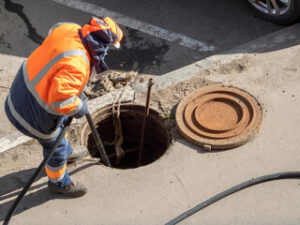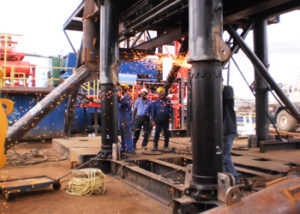A sewer line that’s damaged can cause costly property damage and clogged drains. It’s important to have it repaired as soon as you notice issues like slow drainage.

A professional can use a digital camera to inspect the condition of your pipes. This helps them determine whether you need a repair, replacement, or trenchless replacement.
The pipes that ferry wastewater to and from your home can be made from many different materials. Some are more durable than others. In general, your sewer pipes have a lifespan of 50-100 years, assuming they’re not damaged in other ways. If yours are made from brittle or corrosive materials, they may need to be replaced sooner than that.
Clay is a common pipe material that’s found in older homes. It has a natural resistance to root intrusion and doesn’t crack as easily as other materials. However, it’s also porous. As a result, it can attract tree and shrub roots, which can cause blockages. Clay is also more prone to damage from ground shifts.
Steel sewage pipes were popular several decades ago and are still sometimes used in newer homes. However, they’re prone to rust and corrosion, which can lead to broken pipes and discolored water. These pipes should be replaced with more modern materials when your home needs a new sewer line.
Cast iron is one of the most durable piping materials available. Unfortunately, it’s also very expensive and difficult to work with. It’s not uncommon to see old cast iron piping in homes built before 1970.
Polyvinyl chloride (PVC) is a common plastic piping material that’s inexpensive and easy to install. It has a smooth surface that transports waste efficiently and is resistant to roots. PVC is also nontoxic, making it safe for household use.
If you’re installing a new drain system, consider PVC over other traditional metals. It’s available in a variety of diameters and thicknesses, and it’s more resistant to corrosion than copper.
Wooden pipes are another outdated piping material that can cause problems. Wooden piping is often aerated to reduce the risk of blockages, but it can still get clogged with debris. In addition, it’s important to never connect a downspout to a sanitary sewer. It’s recommended that you have a separate storm sewer for rainwater runoff. This will help keep your sanitary sewer from overflowing during heavy rains and prevent rainwater from flowing into the sewage lines.
Tree Roots
When a tree grows near a sewer line, roots often grow into the pipe looking for moisture and nutrients. The roots can eventually clog the drains and cause other problems that need to be addressed right away. Some signs of a root problem are slow drains, gurgling toilets and sewage smells in the house.
The roots are attracted to cracks or holes in the pipes, and they can also grow into spaces that have been left open by a damaged pipe section. As the roots continue to grow, they can overtake the entire pipe and halt waste flow through the line. The resulting blockage can make it difficult to use toilets, showers and kitchen sinks.
While a plumber may use a mechanical auger to cut through the root growth and flush out the pipes, this is only a temporary solution. The roots will likely grow back in time, so a professional should look into more permanent options such as chemical treatments or sewer pipe replacement.
Chemicals such as copper sulfate can be used to kill the roots and keep them from growing in the pipes again. This product is available at many home improvement and hardware stores, but it should be handled by professionals due to its toxicity and potential for poisoning children or pets. The sulfate is poured down the drain and then flushed several times to ensure it goes through the pipes and reaches the roots. It is then necessary to allow the drain to sit without further flushing for around six hours in order for it to be fully effective.
In cases where the root intrusion is severe, the best option is to remove the affected pipe and install a new one. While this process can be expensive and time-consuming, it will prevent further damage and costly repairs in the future.
The best way to prevent a root problem from occurring in the first place is to plant trees well away from your sewer lines. It is also important to ask your local sewer department or a home inspector where the lines are located before you plant anything.
Galvanized Pipes
One of the most common issues we see with older homes is galvanized pipes. These were a popular option for home builders before the 1960’s, but they aren’t designed to last forever. In fact, they have an expected lifespan of just 40 to 50 years before rust starts to appear in the water supply and cause problems.
The good news is that you can do a simple home inspection to find out if your galvanized pipes are prone to rust or have already started to corrode. The easiest way to tell is by scratching the surface of the pipe with a flathead screwdriver and seeing if it looks silver-gray or sticks to magnets. If it does, it’s probably made of copper or lead, but it will still be a good idea to get these pipes replaced as soon as possible to avoid low water pressure and potential rust stains.
Fortunately, replacing galvanized pipes is relatively easy. Most of these lines are located in unfinished basements and crawl spaces, and they’re usually easy to get to through a hole in the floor or wall. We can flush the lines to remove any sediment that has built up, or we can replace them completely, depending on how bad the corrosion is and whether the damage is causing problems with water flow.
Galvanized drain and waste lines are a bit more difficult to access, and may be hidden under cabinets or in walls. However, these can also be replaced through trenchless sewer repair or by opening up walls and cutting into the slab foundation to access the pipes below. In either case, it’s a good idea to replace these older pipes to avoid leaks and blockages as they deteriorate.
If you are considering getting your galvanized pipes replaced, it’s a good idea to talk with a plumber as soon as possible so that they can advise you of your options. Replacing these pipes will likely involve digging up all the existing ones, and replacing them with new PVC or PEX piping. This will prevent any future plumbing problems and ensure that your family has safe, clean water to drink.
Trenchless Repair
Many people dread the thought of having to get their sewer lines repaired or replaced. Traditionally, the process has been time-consuming and expensive. The good news is that with new technology, it does not have to be. A Brooklyn plumber who specializes in trenchless sewer repairs can perform the necessary work without digging up your yard or ruining your landscape and driveway.
The most common way to repair or replace a sewer line is through the use of trenchless techniques. These methods involve less labor and are much cheaper than traditional excavations. Plus, the results are better for your property and environment.
A trenchless sewer repair method involves inserting a pipe liner into the existing pipes. It’s a great option for repairing or replacing corroded and old pipes. The pipe liner is installed into the sewer system and then cured to create a strong, durable, and long-lasting pipe.
There are several different types of pipe liners that can be used in a trenchless sewer repair, including CIPP and slip lining. CIPP is a resin-based solution that bonds with the inside of your existing pipe to seal any leaks and damage. This type of pipe liner is great for repairing cracks and leaks in your drains, as well as for relining pipes that have been damaged by tree roots.
Another type of trenchless sewer repair is called directional drilling. This process uses a small bore machine to drill down through the dirt and sand to reach the broken line. Then, the technician can insert a new pipe and connect it to the existing one. This is a great option for older homes with large trees that can damage or clog the pipes.
The last type of trenchless sewer repair is called pipe bursting. This technique involves tearing apart your old sewer line and immediately replacing it with a new one. To do this, technicians feed a metal head, also known as a “bursting head” or a “bullet,” through the existing pipe. The bursting head breaks up the old pipe while pulling a new high-density polyethylene (HDPE) pipe behind it. This method is the best for replacing old, damaged, or corroded sewer lines.





